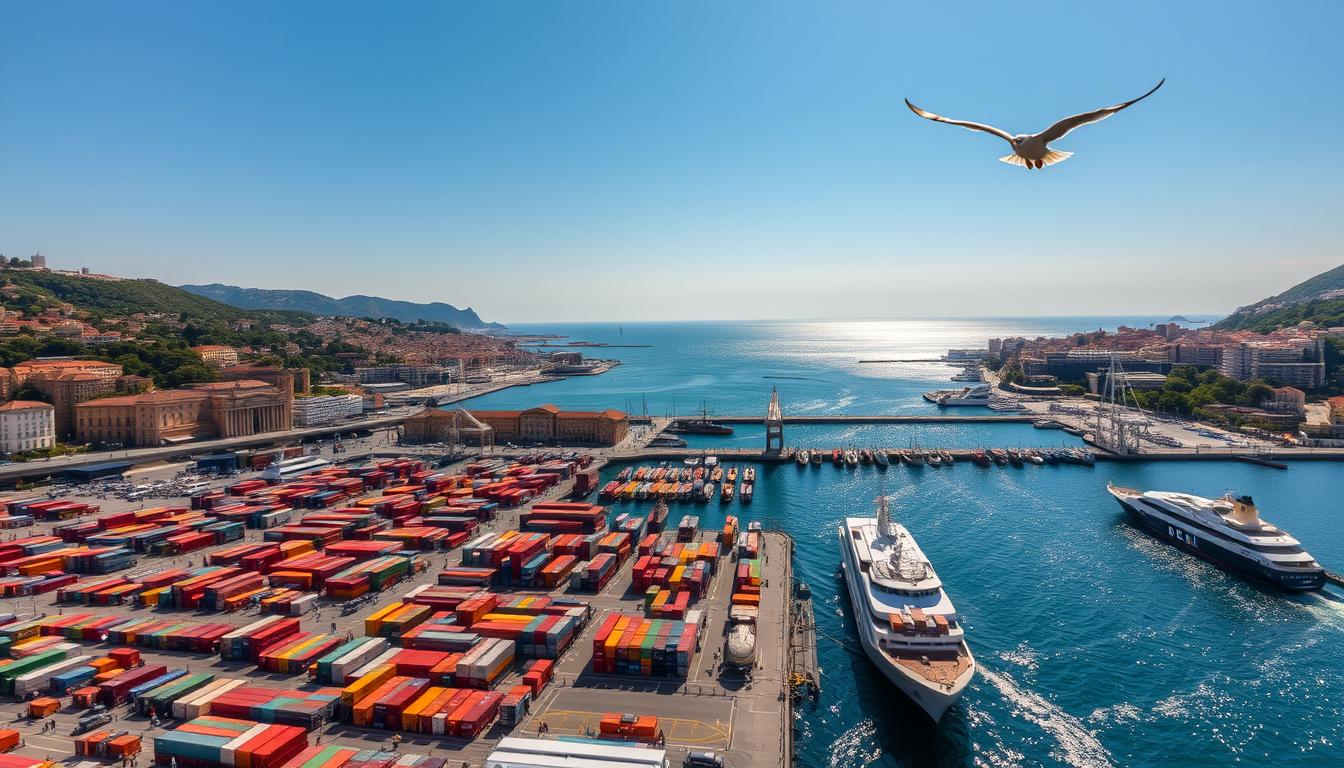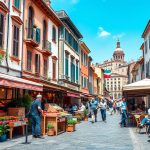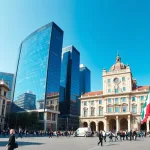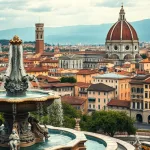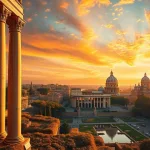Did you know Genoa is one of the world’s oldest ports still in use? It has over 2,000 years of maritime history. This Italian port city is a key player in the Mediterranean trade. It has greatly influenced global trade and cultural exchange.
Genoa’s strategic location makes it a major maritime hub. Its port operations are impressive. We will look into Genoa’s history, current activities, and future in the maritime world.
The Historical Significance of Genoa as a Port City
Genoa’s history as a port city began in the Middle Ages. It became a key maritime power. This period was vital for its growth, making it a key part of the Trade Republic. Its location in the Mediterranean helped it build wide trade networks.
Its shipping industry thrived, with shipyards producing vessels for trade. This made Genoa wealthy and successful.
Historical landmarks show Genoa’s maritime past. The Palazzo San Giorgio was important for trade administration. It shows the city’s power during its best times.
Its architecture also shows the wealth from trade and cultural influences over the years.
Maritime laws helped commerce grow. They protected trade and built trust among merchants. This made Genoa a major player in Mediterranean trade.
Genoa – Being a Port City: Maritime Hub Insights

Genoa is a key spot for maritime activities, thanks to its location. It’s a major stop for trade, making it crucial for maritime trade. The city can handle a wide range of ships, from luxury liners to cargo vessels.
Every year, thousands of ships pass through the port, boosting the economy. Genoa’s role in international trade is vital. It connects Europe with other parts of the world, helping local businesses and drawing in global investments.
Genoa keeps its nautical traditions alive while embracing modern changes. The city celebrates its maritime history with festivals and events. This keeps the port city’s spirit alive in the community.
Learning about Genoa’s role as a port city shows its importance in today’s maritime world. Its strategic location, history, and focus on maritime trade make it a top hub in the Mediterranean.
The Strategic Location of Genoa in the Mediterranean
Genoa is a key spot for international trade, sitting on Italy’s northwestern coast. It has been a major hub for Mediterranean shipping for years. This has made it a big player in global trade.
Being close to big markets in Europe, North Africa, and the Middle East, Genoa is a top choice for shippers. Its location lets it connect quickly with major cities and areas. This makes it a go-to spot for efficient transport.
Genoa’s harbour takes in cargo and passengers, making it a key logistics centre. It has top-notch facilities and deep-water access for all kinds of freight. This means it can handle everything from containers to bulk goods smoothly.
This makes Genoa a crucial link in Mediterranean shipping. It keeps its place as a top gateway for trade.
The following table shows why Genoa is strategically placed:
| Aspect | Details |
|---|---|
| Geographical Position | Northwestern coast of Italy |
| Nearby Markets | Europe, North Africa, Middle East |
| Port Facilities | Deep-water access, container capabilities, bulk handling |
| Shipping Routes | Major Mediterranean shipping routes |
Key Structures and Landmarks in Genoa’s Maritime Infrastructure
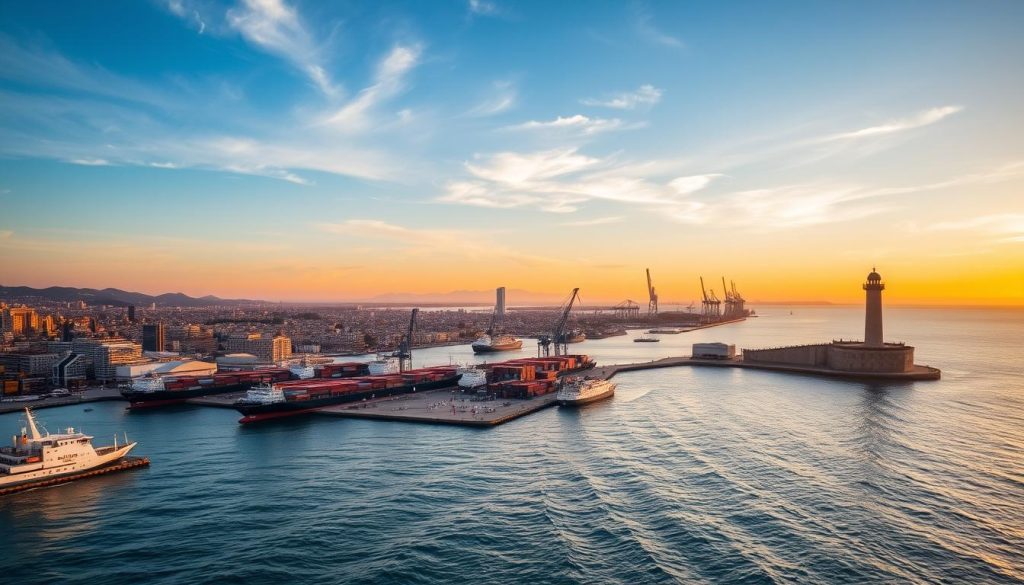
The Genoa port is a key spot for maritime landmarks and structures. It’s Italy’s biggest port and a major trade hub. The port has big docking areas and modern terminals for all kinds of ships.
The Garibaldi Metro Station is near the water and is a key transport spot. It connects people to the port and celebrates Genoa’s maritime history. The Old Port is another gem, now alive with shops, restaurants, and cultural spots.
The Maritime Museum is a must-see for history buffs. It shows off Genoa’s maritime past with artefacts and exhibits. It’s a tribute to the city’s seafaring traditions and big achievements.
| Structure | Description | Significance |
|---|---|---|
| Port of Genoa | Italy’s largest port, includes container terminals. | Key for international trade. |
| Garibaldi Metro Station | Metro station near the waterfront. | Connects transport to the port. |
| Old Port | Revitalised area with shops and eateries. | Historical charm and tourism. |
| Maritime Museum | Exhibits celebrating maritime heritage. | Pivotal for cultural education. |
The Role of Genoa in International Trade
Genoa is a crucial link in global trade, where many trade paths meet. Its location makes it a key spot for trade between Europe, Asia, and Africa. This place helps bring in raw materials and send out finished goods, boosting Genoa’s trade with the world.
Trade Routes and Connections
Genoa’s trade roots go way back to ancient times. Over the years, these paths have changed with the market and new tech. Today, Genoa keeps supporting big global trade. Key routes include:
- Trans-Mediterranean shipping lanes connecting Europe with North Africa.
- Routes that extend to Asia, particularly handling goods from China and India.
- Maritime pathways facilitating trade with the Americas.
Impact on Local Economy
The port’s busy life affects the Genoa economy a lot. It creates jobs in shipping, logistics, and maritime services. This has a big effect on the local economy, offering chances that go beyond the port. Important benefits include:
- Job creation, which boosts employment in the area.
- Diversifying the economy, reducing dependence on one industry.
- Helping tourism grow, thanks to the port’s maritime sights.
Genoa’s trade and local economy work together to create a strong, growing economy. Through its strong sea links, the city proves its importance in global trade. It also makes life better for its people.
Famous Maritime Events Hosted in Genoa
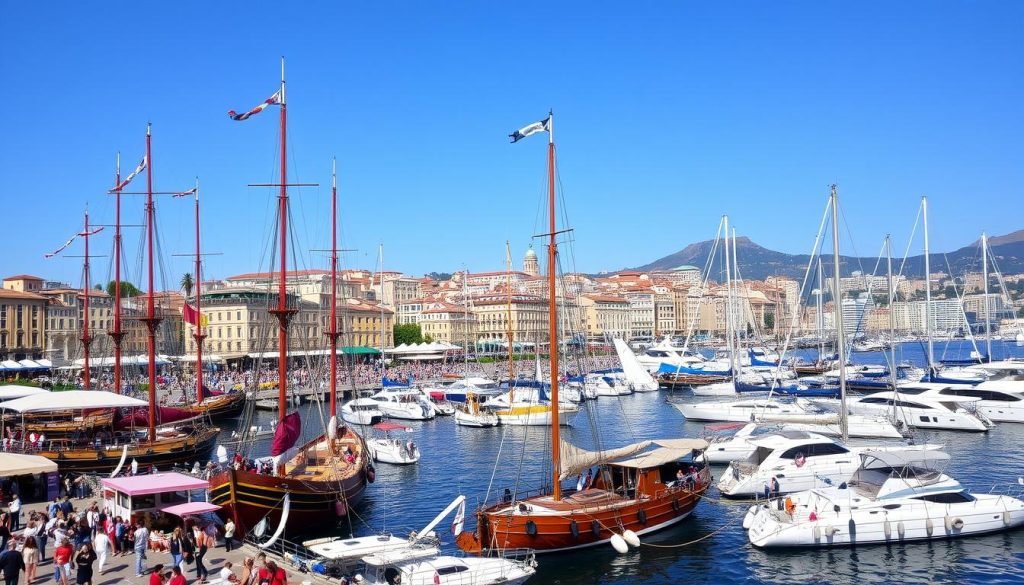
Genoa is known for its vibrant maritime events. These events show off the city’s culture and its long history at sea. They bring people from all over the world to experience Italy’s maritime greatness.
Cultural Festivals Celebrating Maritime Heritage
Cultural festivals in Genoa celebrate its strong maritime roots. The “Genoa Boat Show” is a key event, showing the city’s importance in the maritime world. It attracts boat lovers, industry experts, and families, all keen to see the newest in boat design and technology.
There are sailing demos and workshops too. These activities bring the community together.
Significant Maritime Expositions and Conferences
Genoa is a major spot for maritime conferences and expositions. Industry leaders meet here, offering great chances for networking and sharing knowledge. Events like the “Genoa International Boat Show” showcase the latest technology and tackle big maritime challenges.
Genoa’s Influence on Naval Architecture and Shipbuilding
Genoa has been a key player in naval architecture and shipbuilding for a long time. Its strategic location and deep maritime history have led to many innovations. Artisans in Genoa make ships that are both beautiful and highly functional.
The history of Genoa’s shipbuilding goes back centuries. It’s marked by big steps in design and engineering. Ships built here have gained respect worldwide. This success comes from a deep understanding of the sea and what ships need to do.
Genoa has also led in naval architecture, introducing new ways to make ships more stable and efficient. By mixing old skills with new technology, Genoa has become a top name in maritime engineering. Shipbuilders in Genoa work hard to make sure each ship is a masterpiece of quality and innovation.
The tradition of shipbuilding in Genoa inspires new shipbuilders. They aim to keep the city’s good name. This dedication helps the maritime economy and keeps Genoa’s maritime culture alive.
The Modern Maritime Industry in Genoa
Genoa’s maritime industry is growing fast, with big steps in port operations and facilities. It’s a key player in container shipping, always updating to meet global trade needs. The port now has top-notch logistics and warehousing, making cargo handling better.
Current Port Operations and Facilities
Genoa’s port is getting more efficient with modern facilities for quick cargo handling. These facilities help with strong container shipping. With new warehouses and loading areas, the port makes logistics smooth. Every step of cargo handling uses the latest tech to make things run smoothly.
Technological Advancements in Port Management
Genoa is using new tech to change how it operates. Automated systems and digital tracking make logistics better. This means cargo can be tracked in real-time, making things faster and more transparent. The use of eco-friendly tech shows a focus on sustainability, helping the economy and the planet.
Genoa’s Uniqueness Among Port Cities
Genoa is a standout in a port city comparison thanks to its deep history, culture, and unique maritime identity. Its old architecture and lively traditions show its long-standing heritage. This mix of old and new makes Genoa special, unlike other major ports worldwide.
One key feature of Genoa unique characteristics is its food. The local dishes, like trofie al pesto and fresh seafood, show its deep sea connection. These foods are loved by both visitors and locals, telling the story of the area’s fishing and farming history.
Genoa’s buildings range from medieval palaces to modern waterfront designs. This mix of styles shows the city’s ability to change while keeping its history. The narrow streets and lively sea atmosphere invite people to discover the city’s rich culture.
Genoa’s blend of old and new is also seen in its festivals. Here, traditional maritime customs meet modern art. This mix makes Genoa stand out in the maritime world.
| Characteristic | Genoa | Other Major Port Cities |
|---|---|---|
| Historical Heritage | Rich medieval architecture and traditions | Varied influences, often modernised |
| Local Cuisine | Seafood-focused, rich in flavours | Varies significantly by region and culture |
| Architectural Style | Diverse, blending old and new | Often more uniform in style |
| Cultural Events | Vibrant mix of historic and contemporary | Tends to lean towards either traditional or modern events |
Genoa’s special traits make it a key port city. It combines its past with today’s energy. This city draws people who love its history and modern life.
The Economic Benefits of Being a Port City
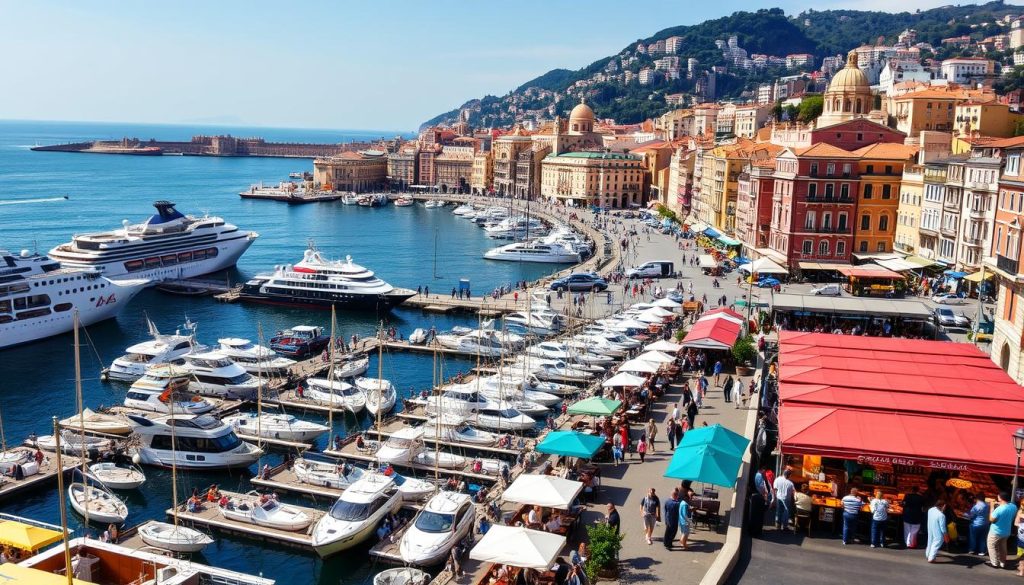
Genoa, a port city, has amazing economic benefits. It creates jobs and diversifies the economy through port activities. The maritime industry links many sectors, like logistics and tourism. This connection boosts jobs and strengthens the economy.
Job Creation and Economic Diversification
Creating jobs in ports helps make Genoa’s economy more diverse. There are many maritime jobs, such as:
- Logistics and supply chain management
- Shipping and freight services
- Ship maintenance and construction
- Tourism-related services
This variety of jobs grows as the port becomes busier. It helps Genoa use its maritime hub status to grow its economy.
The Impact of Tourism on the Maritime Economy
Tourism is key to boosting Genoa’s maritime economy. Visitors come for its maritime history, beautiful waterfront, and cultural festivals. Tourism helps local businesses and creates jobs. It also has other benefits, like:
- Increased support for local restaurants and shops
- Jobs in hospitality and services
- Helping to preserve culture and history
This shows how the port and tourism work together well. Genoa uses its maritime identity to succeed as a port city.
Challenges Faced by Genoa’s Maritime Hub
Genoa is a key maritime hub facing big challenges. These affect its work efficiency and how green it is. The port deals with issues like pollution and competition from other Mediterranean ports. To tackle these, it needs a plan that focuses on being green and working together.
Environmental Concerns and Sustainable Practices
Genoa has many environmental problems, like pollution and harming natural habitats. More ships mean more emissions, which hurts the air and sea. To fix this, the port is starting to use green practices.
- Waste reduction programmes aimed at minimising the ecological footprint from port activities.
- Adoption of eco-friendly technologies such as electric cargo handling equipment.
- Commitments to adhere to strict environmental regulations to protect the surrounding ecosystem.
By going green, Genoa can lead in sustainable shipping. This might draw in companies that care about the planet.
Competition with Other Mediterranean Ports
Genoa faces tough competition from ports like Barcelona, Marseille, and Livorno. This rivalry is due to several factors.
| Port | Capacity (TEU) | Average Turnaround Time (hours) | Services Offered |
|---|---|---|---|
| Genoa | 2,500,000 | 36 | Container, Ro-Ro, Bulk |
| Barcelona | 3,500,000 | 30 | Container, Cruise |
| Marseille | 3,000,000 | 32 | Container, Bulk, Cruise |
| Livorno | 1,800,000 | 44 | Container, Ro-Ro |
This table shows how Genoa compares with other ports in terms of size and speed. New ports in the area are making things harder for Genoa. To stay ahead, Genoa needs to invest in new tech and ideas.
Future Prospects for Genoa as a Global Port City
Genoa is set to grow as a key global port city thanks to strategic investments and new developments. These plans focus on improving its port and making it more efficient. This will help handle bigger ships and improve how goods are moved, boosting maritime trade.
Investments in Infrastructure Development
Investing in infrastructure is crucial for Genoa to stay competitive. Key projects include:
- Upgrading port facilities to support increased shipping traffic.
- Developing logistics hubs that enhance distribution capabilities.
- Implementing smart technologies to optimise port operations.
These projects will keep Genoa at the heart of maritime trade. They will draw in more international shipping lines and logistics firms.
Opportunities for Innovation in Maritime Trade
Innovation is key to Genoa’s maritime future. By embracing new technologies like:
- Blockchain for secure and transparent logistics transactions.
- Artificial Intelligence for optimising asset utilisation and predictive maintenance.
- Green energy solutions to promote sustainability within port operations.
These innovations will make Genoa more attractive as a port city. As the maritime industry changes, Genoa is ready to adapt. It will turn challenges into chances for growth, becoming a model for modern ports.
Local Cuisine: A Taste of Maritime Culture in Genoa
Genoa’s food scene is a mix of maritime tastes, showing off the city’s coastal roots. Dishes like pesto alla Genovese, with fresh basil and Parmigiano-Reggiano, highlight local tastes. Focaccia, a scented flatbread, is a favourite, often eaten with seafood.
Genoa’s food uses fresh ingredients from land and sea. Being close to the Ligurian Sea means seafood is a big part of meals. Dishes like cuttlefish and octopus are staples, passed down through generations.
Local flavours shine in dishes prepared with steaming and grilling. These methods keep seafood’s natural taste. Festivals celebrating local foods bring together locals and visitors to enjoy Genoa’s sea-based traditions.
Genoa’s food scene blends history and new tastes, making it stand out in Italy. It keeps traditional recipes alive while trying new ways of cooking. This keeps Genoa’s seafood-based cuisine vibrant and evolving.
Conclusion: The Ever-Evolving Identity of Genoa as a Maritime Hub
Genoa’s maritime identity is deeply rooted in history. It has grown into a key maritime hub over the years. This city has become a centre for trade and culture, thanks to its rich heritage.
It faces challenges like environmental issues and competition from other ports. Yet, these challenges drive innovation. With ongoing investments, Genoa is set to improve its maritime infrastructure and operations. The city is embracing technology to stay ahead in the maritime industry.
Genoa is a symbol of resilience and adaptability in the maritime world. Its identity evolves with a mix of history and new strategies. This approach helps Genoa keep its legacy while looking forward to a bright future in global maritime.

